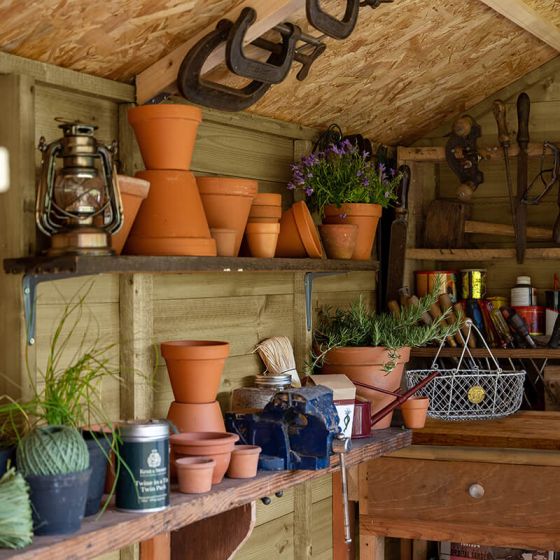From the Potting Shed, with Chris Milborne
From the potting shed...

Our monthly gardening newsletter, written by our Great Amwell plant department colleague, Chris Milborne.
October 2024.
October marks the start of a new season in the garden with the beginning of Autumn colours, mists and a seemingly low, orange sun that provides a wonderful light.
Plant growth begins to slow down and some plants start to die back. Our gardens still look colourful though with the help of Cosmos, Dahlias, Rudbeckias and Echinacea that keep flowering. Wonderful seed heads form on grasses and many look particularly good with their dramatic arching stems as they turn from green to orange in October’s changing light. There are still plenty of other shrubs and herbaceous perennials that provide an array of further glorious colours.
There is still plenty of time to harvest vegetables and pick fruit and October is also a time to look at houseplants as we spend less time in the garden.
Time to Plan
When planning changes in the garden for next year, I take photographs to identify which areas could do with improvement and regularly updating the garden with new plants and ideas helps to keep the garden looking fresh. Gardens continually change as they age and when I look at photos taken a few years ago I am amazed just how much the trees, shrubs and herbaceous plants have grown.
When recently doing this, I noticed that a clump of Crocosmia Lucifer had become overgrown and this will need to be replanted. Photos also provide a reminder of where herbaceous plants are located as many of these die back in the winter and it is easy to lose track of them. Dormant buds that lie just below the soil surface can easily get damaged when digging or hoeing as we tidy the beds and borders. Photos also provide a visual reminder where bulbs have been planted.
Plant
October is the perfect month to plant trees, shrubs and other perennials as the soil is warm from the summer and, combined with all the autumnal rain we’ve had, it is perfect this year. As many trees and deciduous shrubs have no new leaf growth, plants don't lose water through transpiration and the roots form a good root system before next Spring or perhaps next year’s dry summer weather.
When planting add some bone meal or a slow-release fertilizer that helps with root establishment or consider a Mycorrhizal feed, a naturally forming fungus that stimulates root systems. This will help roots uptake nutrients from the sol improving growth, plus a good mulch of organic matter round the plant will help maintain healthy soil.
Autumn is a good time to divide clumps of herbaceous perennials that are overgrown or have perhaps been there 4 or 5 years and may not be growing quite so well. Division will help give new vigour to plants.
Herbaceous plants with fibrous roots are easily teased apart, while other clump forming types can be split using forks back-to-back and some with fleshy roots may need splitting with a spade or even an old saw. Once split, replant as soon as possible and water in well. Don't allow the plant to dry out until it is well established and provide a good mulch. With clumps of grasses these are split in the Spring when new growth is starting to form.
Glorious Autumn Colours
Towards the end of October with longer, cooler nights, leaves on many deciduous plants turn shades of bright red, orange and yellow plus some shrubs and trees with berries and fruits will provide extra colour and interest. For best vibrant leaf colours, you need warm days and cold nights and ideally no winds for the displays to last longer.
Perhaps one of the best for leaf colour is Japanese Acers as their stunning leaves change through every shade of orange, red and yellow before they fall. Other good plants for autumn colour include Cotinus, Liquidamber Straciflua Euonymus Alatus, Cercidiphyllum Japonicum and the vigorous climbers Parthenocissus.
Evergreen Leucothoes and Nandinias are both shade loving plants that produce stunning colours and interesting leaf shapes and are very easy to grow.
Pyracantha, the firethorn, is a prickly evergreen shrub either grown free standing or trained against a wall or fence and is also good planted in a mixed hedge in the glorious autumn colours amongst Climbing Roses that produce bright red hips Pyracantha depending on which variety produces red orange and yellow berries that last last well into winter.
Crab apples (ornamental Malus) are some of the best trees for a smaller garden with lovely Spring blossom and colourful fruit and golden coloured leaves in the autumn. Some of the smaller fruiting varieties are a popular food source for many species of birds. Other good trees include Crataegus which have red berries loved by blackbirds and good autumn colour.
Other plant highlights for October include:
Abelia, Caryopteris, hardy Fuchsias, Ceratostigma and for berries and fruit Callicarpa Chaenomeles Cotoneaster, a group that include low growing shrubs good for ground cover or large shrubs for the back of the border. Hypericum Miracle plus the winter interest plant, Skimmia Reevesiana. Fabulous herbaceous perennials at this time of the year include Actaeas, Japanese Anemones Asters, Penstemons and Rudbeckias.
October Jobs
Continue to deadhead plants such as Dahlias and they will continue producing flowers until the first frosts.
Recycle your leaves. As leaves start to fall rake them up and use them to make your own leaf mould. Store them in large bin bags (puncture some holes) or compost bins and within a year or two they will provide a rich organic compost that ultimately feeds the soil and then the plants. I place some of the leaves under hedges for over-wintering insects and wildlife to provide a safe haven from cold winter weather.
Lawns
With this year’s average rainfall lawns are looking good and are still making luscious new growth. If not started last month, now is a really good time to aerate the lawn using a garden fork making holes at least 3 to 4 ins deep (8-10cm) to help prevent compaction and winter waterlogging. Rake away thatch, old grass clippings and moss and repair any dead patches and sow some fresh seed. Straighten and repair lawn edges and sort out any bumps and hollows. The lawn will also benefit from a feed of Autumn Lawn Feed which is high is potash to boost root growth. If you want an instant lawn October is a good time to lay turf as the soil and weather conditions allows for good root establishment.
Compost
If not started in September, make your own compost and build or buy a compost bin to utilise all the garden green waste generated by the Autumn pruning and garden maintenance. To make successful compost you need beneficial bacteria found in the soil moisture and natural ingredients including annual weeds, fallen leaves, grass mowings, soft hedge clippings, tea bags and potato peelings plus you can use shredded paper and cardboard but avoid any diseased material, woody stems and perennial weeds. Within a year or so you should have a good supply of organic compost ready to mulch round your plants, beds and borders enriching the soil.
Grow Your Own
Time to plant spring cabbages and over wintering onion sets and also to plant out garlic cloves as these benefit from the cold winter weather. In the greenhouse, once tomato plants have been cleared sow winter lettuce, baby spinach leaves, early carrots, corn salad and spring onions, for out of season crops - just watch out for slugs!
Find space to grow more soft fruit as summer fruits can be expensive to buy and there is limited choice in supermarkets. Black Currants, Gooseberries, Blackberries, Loganberries, Raspberries, White and Red Currant and Blueberries need ericaceous soil and are easy to grow in pots if the soil type is not suitable. All of these plants can grow in a soft front area or combine with other plants in your mixed border.
Colourful Containers
Plant up tubs, containers and hanging baskets using pansies, violas bedding cyclamen, Calluna Vulgaris, handy evergreen heathers flowering late summer and autumn, perennial grasses Phormiums and Cordylines with upright colourful foliage. Evergreen Nandinias and Leucothoes are good for foliage that turns red in the autumn or you can use evergreen shrubs.
Try colourful Heucheras or Hellebores with interesting patterned foliage and dramatic flowers from late winter to spring. Use a few trailing plants to cascade over the edges and between plants, for further spring interest and colour, add Crocus Dwarf Narcissus and Dwarf Tulips.
Last month we started planting, spring flowering bulbs but I would say that October is the main month for planting them. With all the rain we had in September, the soil is perfect for planting this year. Daffodils are a firm favourite with most gardeners producing bright trumpet-shaped flowers in every shade of yellow. Their arrival means that spring has almost arrived and they look superb is pots and containers and are ideal for naturalising in the garden giving years of colour in Spring.
The botanical name for Daffodils is Narcissus, a name from Greek mythology. Narcissus was a youth who fell in love with his own reflection in a pool. Narcissus have a fascinating history originating in an area of Europe, especially Spain and Portugal and were found in meadows and woodlands. They was brought to Britain by the Romans who believed they had medicinal properties and as a garden plant became increasingly popular after the 16th century. In the 19th century it was an important commercial crop resulting in thousands of different cultivars. I have found that Daffodil bulbs are not dug by squirrels or eaten by mice unlike some other bulbs.
Crocus also need to be planted now. These are available in a wide range of colours - white, yellow, orange or purple. Crocus are native to southern Europe, the Mediterranean and North Africa and are usually found under deciduous trees and shrubs and meadows so they are ideal for many situations in the garden or in clumps, in the lawn or round the edges of planted containers. Start planting Tulips from October onwards, even up to Christmas as they only start making roots in cooler weather conditions. A plant native to Turkey and Asia Minor where the weather is cold in winter, rainy in spring and has hot, dry summers. So if leaving bulbs in the ground from year to year try and find a spot that is south-facing that is warm and dry during July and August.
Tulips are spectacular flowers with so many shapes and colours but personally I still prefer the classic Tulip with its wine glass shape. Plant up bulbs for forcing such as Hyacinths Narcissus and start planting Amaryllis bulbs inside for spectacular displays from Christmas to spring.
Houseplants
With the shortening and often, damp days of the season, it’s a good time to take a look at your houseplants that were perhaps neglected over the summer. Remove any dead leaves, clean remaining leaves, check for any pests and diseases and add a top dressing or fresh compost.
Create a miniature houseplant garden inside, easily achieved by planting up a Terrarium. This could be an old fish tank on a large glass jar, just make sure the opening is large enough to get your hand in to add plants and for maintenance. If you are uncertain, Blue Diamond stock a wide range of terrariums. Growing in glass containers started with Dr Nathaniel Ward who, in 1829, noticed that ferns thrived in a sealed glass and from these early beginnings the ‘Wardian Case' was designed and used to bring back plants from around the World resulting in fewer plant losses. The Victorians enjoyed growing ferns and foliage planted in glass containers.
Plants that grow in glass containers rarely need watering as the humidity generated within helps to keep the atmosphere moist. This is particularly good for plants that don't normally thrive in the dry of our homes or those that are affected by cold draughts.
Avoid plants such an cacti and succulents that require dry conditions and avoid fast growing plants such as ivy. I also avoid using flowering plants but if used, plant in pots so that they can easily be lifted out when flowering is finished.
When planting place about an inch of gravel on the base of the container for drainage. Add 1-2 teaspoons of activated carbon or crushed charcoal to the compost as this keep compost sweet. Compost should be approximately 1 -2 inches deep for plants to root into.
The inside of the terrarium can be landscaped with bits of old bark and stones etc. Place the plants in the container and see how they look together - similar to designing a flower border outside but in miniature. Choosing a selection of plants with different leaf shapes, textures colours and height will provide a fantastic visual display. Between plants add ferns as the fresh green leaves makes other colourful leaved plants stand out better. Some of the plants suitable include Fittonias Ficus Pumila, small Syngoniums Peperomia, Begonia Rex and Ferns. One of my favourite terrariums is growing a collection of Carnivorous plants such as Sarracenias Nepenthes, Venus Fly Traps together with Cryptanthus or Guzmania and ferns looks very natural and grow well in the conditions provided. Terrariums are easy to maintain but don't overwater - regular misting is better.
October can start with warm and pleasant weather but by the end, with the short days it can really feel like winter is on the way. Start preparing - have some horticultural fleece ready to provide protection for the more tender plants and any citrus outside needs to be brought into a light, frost free area inside (but not a warm centrally heated room as this will result in leaf fall).
Have a good gardening month!


